Machu Picchu is Peru’s most popular tourist attraction and one of the world’s most famous archeological sites.
In this extensive Machu Picchu facts article we have tried to distill the most interesting and fun facts about this famous city ruin, the people who built it and the region at large.
Each Machu Picchu fact takes the form of an FAQ.
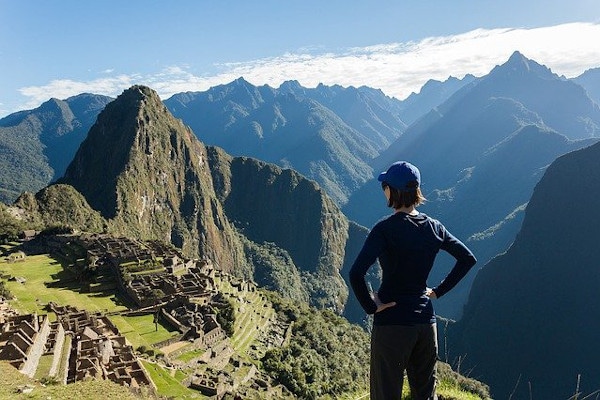
Get a Machu Picchu trek quote
Start planning your Machu Picchu hiking holiday.
General Facts about Machu Picchu
Where is Machu Picchu located?
Machu Picchu is located in the Cusco region of Peru, within the Urabamba Province.
The site is 80km North-west of Cusco City. Its exact geographic coordinates are 13.1633° S, 72.5456° W.
The Citadel sits in the saddle of two mountain peaks. Huayna Picchu (Young Peak) in the North and Machu Picchu Mountain (Old Peak) in the South. The outer sides of these mountains mark the location of two fault lines, which make Machu Picchu susceptible to earthquakes and landslides.
To counter these risks the Incas built elaborate terraces and internal structures that are earthquake-proof (more on this below)
The ruins sit at 2,430m (7,970 feet) above sea level.
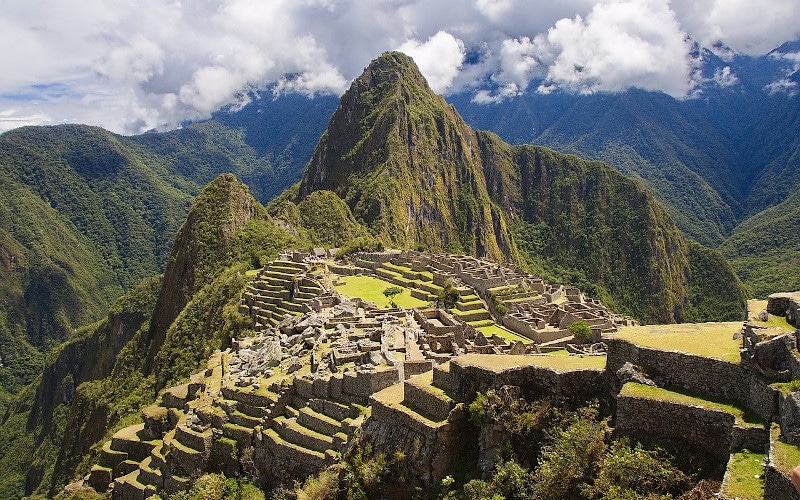
How old is Machu Picchu?
For decades, it was believed that Machu Picchu dated back to 1450. However, new evidence shows that the Incan site goes back as far as 1420. This means that Machu Picchu is around 600 years old.
To age Machu Picchu, a team of anthropologists used advanced carbon dating on remains uncovered in 1912. The findings from this method are much more accurate. Previously, Machu Picchu’s age came from the documents of Spanish Conquerers. Historians also studied knotted Incan records (Quipas).
What was Machu Picchu built for?
New technology in radiocarbon dating suggests that Machu Picchu was inhabited between 1420 and 1532. It is believed to have taken over 50 years and hundreds of workers to complete its construction.
The settlement is an architectural marvel. The walls are made of large stone blocks. These have been shaped, polished, and fitted together without any filler or adhesive.
Historians still have some disagreement over the true purpose of Machu Picchu. The Incans did not have a written language. Without a recorded history to decipher, we can only draw conclusions based on what we see. There are a few widely accepted theories as to what Machu Picchu was used for.
The leading consensus is that Machu Picchu was an estate designed for Pachacuti. This Incan Emperor was around between 1438-1472.
Pachacuti was an influential figure in Incan history. Under his reign, Cusco became a great empire. Incan territories expanded 2,500 miles outwards from the Cusco region. It is plausible that Pachacuti had Machu Picchu built as a royal retreat in celebration of his many conquests.
In addition to being a royal residence, Machu Picchu was a sacred site and place of worship. The type of buildings found here indicates it was also a political and administrative centre. Agricultural terraces on the slopes were used to farm crops to feed the city.
Up to 1000 people could have lived in Machu Picchu. Most of these residents would have been workers. A large staff was needed for palace maintenance and royal service. Staff family members and religious leaders also lived in the city. Forensic evidence suggests these people were from a diversity of backgrounds across Peru.
How big is Machu Picchu?
Machu Picchu covers an area of 35,592 hectares. It is one of the largest archaeological sites in the world. By measurement, it is about 530m long and 200m wide. The site can be split into 2 main areas.
The agricultural zone is in the south. Here you will see multiple large terraces (they look like giant staircases). There are also warehouses in this area. These were for storing grains, potatoes, and other food.
The residential area is separated from the terraces by a wall and a water channel. This area can be further divided into housing classes. The Royal residence is distinctly separate from the workers’ and staff housing. The religious structures are closely clustered. This includes the Sun Temple and Sacred Plaza.
In 2005 and 2009, the University of Arkansas made fascinating 3D scans of the entire Machu Picchu complex. Peter Olson from Sydney Australia turned these 3D images into this awesome video model of Machu Picchu.
How did the Incans move the stones seen at Machu Picchu?
Most of Machu Picchu was constructed in the Classical Inca style with dry polished walls. The Incas were masters of the construction technique called ashlar, in which stones are cut and moulded to fit together perfectly, without the use of mortar.
Some stone features in Machu Picchu are so perfect that it is difficult to even insert a blade of grass between them.
The stones that were used to build the 200 or so buildings at Machu Picchu were created from a quarry nearby the city. The ashlar technique was a critical design feature that provided additional building strength for the city which was built in an earthquake-prone area.
Chips for the ashlar stones were used to build the vast array of terraces that surround Machu Picchu, and provide an efficient drainage system that reduces the risk of landslides. There are over 700 agricultural terraces in and around Machu Picchu.
The terraces are incredibly efficient at drainage, which any engineer or golf designer will tell you is key to stability in a landscape.
The structures within Machu Picchu were also constructed in a style that would protect the integrity of the building in the event of an earthquake. Doors and windows are trapezoidal in shape, tilting inwards for strength.
It is believed that the Incas never used wheels or pack animals to move and place stones as the steep gradient of the city would have rendered these techniques useless.
The exact way that the Incas managed to move and place stones is still unknown, although it is very likely they used manpower to push and lever stones using wooden structures and ropes tied around stony knobs that were fashioned on the stones.
Some of these knobs can still be seen on certain stone structures within the building, although most were filed flat.
What are the main ruins at Machu Picchu?
The primary archaeological sites are the Inti Watana (aka Intihuatana), the Temple of the Sun and the Room of the Three Windows – all dedicated to their greatest deity, the Sun God.
Inti Watana (Intihuatana)
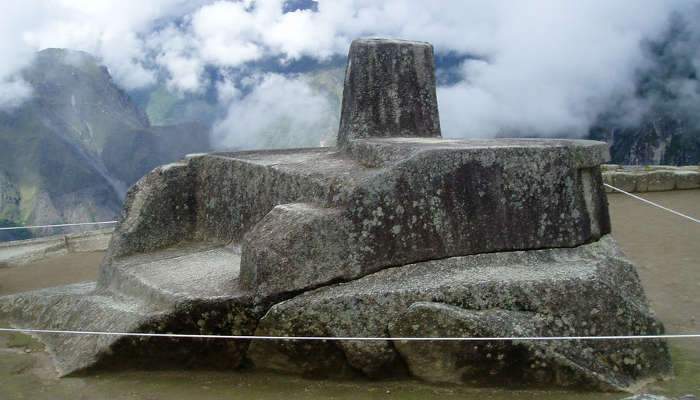
Intihuatana
Inti Watana (aka as the ‘The Hitching Post of the Sun’) is a stone placed within Machu Picchu’s Citadel that points directly at the sun during the winter solstice. It is believed that the Inca’s thought the Inti Watana kept the sun on it’s path as it travelled through sky during the year.
On November 11th and January 31st, the sun stands directly above the stone at midday, and casts no shadow. On the 21st June the stone casts the longest shadow to it’s northern side at midday, and a lesser shadow on it’s southern side on the 21st December.
Archeologists and anthropologists believe the Inti Watana served as a astronomic clock or calendar.
The Temple of the Sun
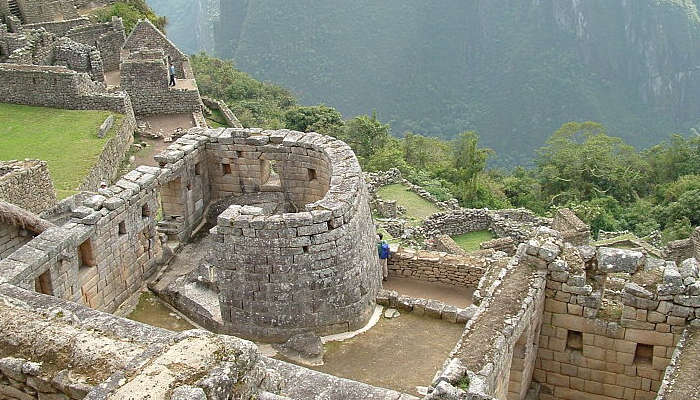
The Temple of the Sun
The Temple of the Sun is a semi-circular building that sits above the Inti Mach’ay, and was built into the natural environment with a large stone forming the foundation of the structure.
It is thought that the Temple of the Sun was used as a solar observatory, with the two windows in the structure related to the Summer and Winter solstice.
Inti Mach’ay
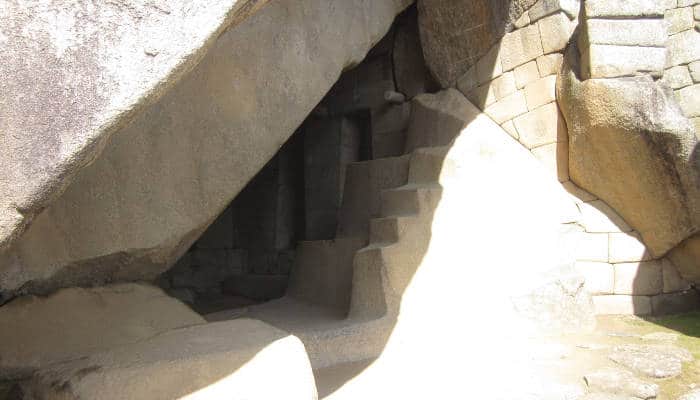
Inti Mach'ay
Inti Mach’ay is a cave that is situated below the Temple of the Sun. It is believed to have been designed and constructed to celebrate the Royal Feast of the Sun, a Inca festival celebrated by the nobility during the December solstice.
The Inti Mach’ay is one of Machu Picchu’s most impressive architectural structures. Inside the cave tunnel is a window unlike any constructed by the Inca’s, which is strategically aligned to only allow sunlight into the structure during a few days of the December Solstice.
The Room or Temple or Three Windows
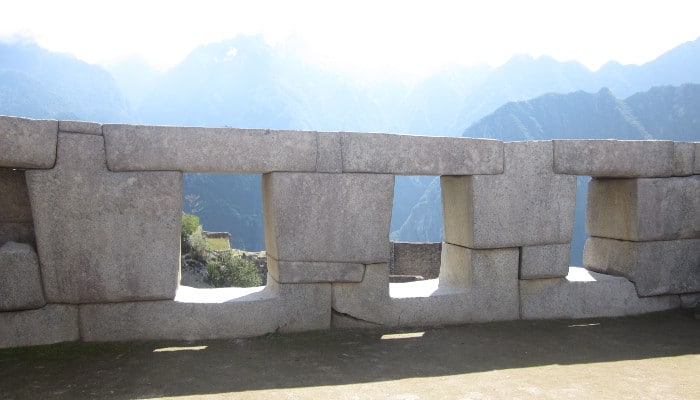
The Temple of Three Windows
The Temple of Three Windows is a beautiful structure fashioned from large polished stones that are artfully placed to create three windows that over look the lower city at Machu Picchu, and frame the mountainous landscape. The windows are situated in the Royal sector of Machu Picchu.
The exact purpose is unknown, although it is clear that there were originally five windows. When Bingham saw the windows he surmised that they represented three mythological caves from which the Ayar brothers, children of the sun, stepped into the world.
It has also been suggested that the windows represent the underground, the heavens and the earth.
When Was Machu Picchu Discovered?
The first westerner to discover Machu Picchu was an American Academic named Hiram Bingham. Bingham was a lecturer at Yale. With funding from the university, he began an expedition in Peru in 1911. He was on a mission to discover what was described as the ‘Golden City Of The Incas’.
After speaking with locals in the area, Bingham found out about ruins at the bottom of the Urubamba valley. An old prospector mentioned some interesting ruins at Huayna Picchu.
It was an innkeeper named Melchor Arteaga who told Bingham of the exact location of Machu Picchu. Melchor was also a farmer and knew the area well.
The day after telling Bingham about the ruins, he led the way for Bingham and Sergeant Carrasco. They crossed the river by a log bridge and ascended the mountain.
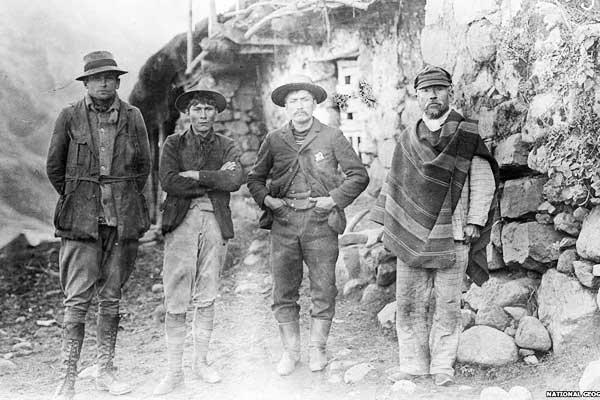
Quechua farmers were living near the top. They were farming some of the original terraces. An 11-year-old farmer’s son (Pablito) took Bingham along the ridge to the ruins. The site was completely covered by vegetation. They needed to crawl through bush to access the buildings.
Bingham returned to Machu Picchu in 1912 with a full team. This expedition was funded partially by National Geographic. It took four months to clear the vegetation
Note: Other adventurers may have reached Machu Picchu before Bingham’s official expedition. Some records suggest a German businessman (Augusto Burns) visited the site as early as 1867. If this is true, it's very likely he also removed valuable items from the site.
Disputes over artefacts from Machu Picchu
During Bingham’s visits to Machu Picchu in 1912, 1914 and 1915, many artefacts – including silver statues, bones, mummies and ceramics – were removed from the city ruins for further study at Yale.
The artefacts were meant to be returned after 18 months, but were only officially returned in their entirety in 2012. Yale claimed the delay in returning the artefacts was on account of Peru’s poor infrastructure and resources to properly take care of them.
In 2006 some of the artefacts were returned to Peru, and in 2007 an agreement was reached which included sponsorship, a travelling exhibition and the construction of a museum and research centre in Cusco to house a shared collection of artefacts.
However, only a portion of the artefacts were included in this joint partnership.
In 2010 it was agreed that Yale would return the final collection of artefacts to Peru, all of which were delivered in November 2012.
Today, one can go see all these artefacts at La Casa Concha (The Shell House) in Cusco.

Get a Machu Picchu trek quote
Start planning your Machu Picchu hiking holiday.
Why is Machu Picchu important?
The Crown Jewel Of Incan Civilisation
Machu Picchu is part of the ancient Incan civilisation. The city was built at the height of this empire’s power. It represents the peak period in Incan architecture and spirituality.
The Ancient Incans were dominant in the Western parts of South America between the 1500s and 1600s. Incans are famous in history for their incredible architectural designs and deep spirituality.
Incan ruins are scattered down the continent. When visiting these sites, we can marvel at the time, effort, and intelligence it took to construct these buildings. In many places, the stone walls have endured for hundreds of years.
The Incans also constructed an impressive network of roads known as the Qhapaq Nan. These pathways cover approximately 40,000km (25,000 miles). They link Peru, Ecuador, Columbia, Bolivia, Chile and Argentina.
The most famous stretch of the Incan pathway is the Inca Trail to Machu Picchu. Many believe this trail was used exclusively by royalty as a religious passage to Machu Picchu.
Ancient Incans had a complex belief system. Their religion centers around natural elements and deities governing them. Mountains were particularly sacred to the Incan people. Machu Picchu's location between peaks further increases its importance.
You may also like: Inca trail facts and the history of the Inca trail.
An Icon Of Peru’s Cultural Heritage
Most of Peru’s people descended from the Incas. The rich culture in this country is an inheritance of customs and beliefs passed down from Incan ancestors. Quechua, Peru’s native language comes directly from the Incas.
The lost city is more than just a tourist destination. To the indigenous people of Peru, this is a sacred site. The location and design of the temple hold a powerful religious significance. Machu Picchu is still hugely relevant within Peruvian culture.
Heavy tourism along the Inca Trail and around the ruins is speeding up degradation. This is a serious threat to the national heritage site. Authorities need to weigh up the benefits of tourism vs protecting local cultures.
Machu Picchu, A World Wonder
In 1981 the Peruvian government made Machu Picchu a Historical Sanctuary. UNESCO followed suit shortly after and declared Machu Picchu a World Heritage Site in 1983.
There are over 1,200 World Heritage Sites across the globe, 11 of which are in Peru. Machu Picchu is by far the most popular. Cusco City is also a World Heritage Site.
In 2007, Machu Picchu was voted a New Seven Wonder of the World. The other six sites are: The Great Wall of China, Chichen Itza (Mexico), Petra (Jordan), Christ the Redeemer (Brazil), Colosseum (Italy) and Taj Majal (India). The Great Pyramid of Giza was later included as an honorary candidate.
Looking for a day tour? Here are my 5 favourite day tours around Cusco:
- Rainbow Mountain day trip (with meals)
- Moray and Salt Mines Quad Bike Tour
- Sacred Valley day tour
- Humantay Lake day tour
- Machu Picchu and Huayna Picchu entrance tickets
See more Cusco day trips.
Why was Machu Picchu abandoned?
Only 80-120 years after it was built, the Incas fled Machu Picchu. This was around the year 1572. Sadly, it took almost the same amount of time to build the city as it was inhabited.
No one is entirely sure why Machu Picchu was abandoned.
Here we look at the top theories:
1. Machu Picchu was abandoned to evade the Spanish
It’s no coincidence that the late 1500s is when Spanish conquerors landed in Peru. Most people believe that the sudden departure from Machu Picchu was to prevent the Spaniards from finding this sacred and royal place.
A messenger probably alerted Machu Picchu residents of Spanish Invaders. Messengers on the Inca Trail were exceptionally fit and fast runners. It was their duty to transfer ‘notes’ between the different towns and sites on the trail.
2. Inhabitants left Machu Picchu left more gradually
A second possibility is that people slowly moved out of the sacred Incan city. During the final years before the Incan Empire fell, there were constant rebel wars in Vilcabamba.
Some reports suggest that many inhabitants were recruited to join the rebels fighting in the valley. As a result, Machu Picchu lost most of its population.
An agreement was reached after the Spanish victory. The Incans of Vilcabamba agreed to let Spanish friars evangelise the remaining Machu Picchu residents. It may have been these religious leaders that burnt down the Temple of the Sun.
After the Spanish conquest. Most of Machu Picchu’s residents moved out of the city. Those (if any) that remained lived a very isolated and simple life.
3. There was a plague at Machu Picchu
A third theory suggests that a foreign plague wiped out the Incas at Machu Picchu. It is possible that the European invaders brought foreign diseases into Peru. The local people would have had no immunity to diseases like smallpox.
If this is the case, it is strange that more graves have not been found close to Machu Picchu. For this reason, the ‘plague’ theory is often discredited.
How do you pronounce Machu Picchu?
If you are wondering how to pronounce Machu Picchu, it’s ‘Maa-choo Pee-choo’. When listening to Spanish speakers, it sounds closer to ‘Mat-Ju Pit-Ju’. Either way, the first ‘c’ in ‘Picchu’ is silent.
Did Machu Picchu have a name change?
Hiram Bingham unintentionally gave Machu Picchu the wrong name. This is according to a recent paper in the Journal of the Institute of Andean Studies. The authors explain that Incan residents knew the site as Huayna Picchu or simply Picchu. This is based on evidence from historic documents and some of the area’s first maps.
What Does Machu Picchu Mean?
Directly translated to English, the definition of Machu Picchu is ‘Old Mountain’. The name ‘Machu Picchu’ comes from Quechua. This indigenous language of Peru is still widely spoken in the Andes.
In Quechua, ‘Machu’ almost always means old. This was the name given to the site by locals. It got this name because of the age and state of abandonment of the structures.
After its discovery, Bingham received official documentation to allow work on the site. This paperwork from the Peruvian State showed the mountain’s recorded name; ‘Picchu’.
‘Picchu’ has several different interpretations. It can refer to a mountain, a pyramid structure, or (oddly) chewed coca leaves.
Hiram Bingham combined the local nickname with the name of the mountain to get ‘Machu Picchu’.
Facts about visiting Machu Picchu
Why visit Machu Picchu?
Machu Picchu is famous for being the most iconic settlement of the Incan civilisation. Tens of thousands of visitors make the trip each year to marvel at the ruins and imagine life in this lost city.
Incan culture is tightly interwoven with rich spiritual beliefs. During a tour of Machu Picchu, you learn about the residents’ fascinating history and religion.
If you choose to trek to Machu Picchu, you will get to experience your own pilgrimage to the citadel. This is a physically and emotionally rewarding experience. It also provides a chance to better connect with Incan culture.
The Incans had design and construction abilities well ahead of their time. Even if you are not a history buff, a visit to Machu Picchu is worthwhile. It is impressive to think about the skill and effort it took to build these structures.
If you visit Machu Picchu, you will see that some of the buildings are reconstructed. This has been done to provide a better idea of what this magnificent settlement once looked like. The reconstructed walls are nowhere near as good craftsmanship as the original structures.
You may also like: Things to do in Machu Picchu and hiking Huayna Picchu
How many people visit Machu Picchu?
Machu Picchu is Peru’s most popular tourist attraction. Just short of 1.2 million people visited Machu Picchu in 2013, a 700% increase from the early 1980s where the annual average number of visitors was 100,000.
More than two thirds of the visitors to Machu Picchu are foreigners as opposed to Peruvians who account for just under one third of visitors.
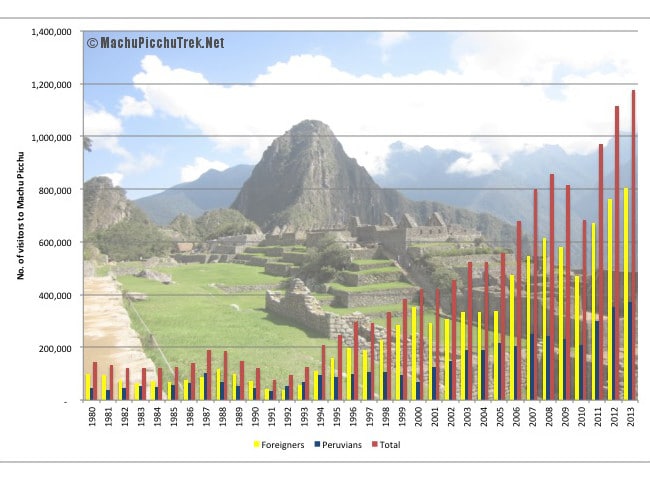
The World Monuments Fund placed Machu Picchu on their 2008 Watch List of the 100 Most Endangered Sites in the world due to the impact of tourism on the city ruins and the development and encroachment of the town of Aguas Calientes in the valley below Machu Picchu.
UNESCO have also threatened to placed Machu Picchu on their endangered list of World Heritage sites.
Concern over degradation to the site has led the Peruvian government to restrict the total number of entrance tickets per day to 2,500 permits.
Is it worth getting a registered Machu Picchu guide?
Having some expert interpretation will greatly enrich your experience of Machu Picchu. There are no information boards and you miss a lot if you don't know what you are looking at.
If you have booked an organised tour/ trek it will include a guided tour of Machu Picchu. You can find a guide through agencies in Cusco or online. I strongly recommend checking online ratings. Finally, you will have no shortage of offers from freelance guides. These guys will approach you outside the entrance. Don’t be afraid to negotiate prices. See our top picks of Machu Picchu tours and companies.
Alternatively, do a lot of reading about Machu Picchu beforehand. Check out our list of recommended Machu Picchu guidebooks.
Recommended reading
If you are planning of visiting or trekking to Machu Picchu and want to read some excellent books about the city and Incas, we recommend Hugh Thomson’s seminal book called The White Rock: An Exploration of the Inca Heartland or Mark Adam’s entertaining book that retraces his journey to Machu Picchu, called Turn Right at Machu Picchu: Rediscovering the Lost City One Step at a Time.
If you looking for something a little more rigourous you should definitely check out Kim MacQuarrie’s The Last Days of the Incas.
Is Machu Picchu open all year round?
It is possible to visit Machu Picchu 365 days a year. Machu Picchu gates are open every day between 6 am and 5:30 pm. This includes public holidays.
If you are planning on trekking to Machu Picchu, keep in mind that the Inca Trail is closed over February. Many of the alternative routes to Machu Picchu are still open during this month.
There are a few important things you need to know when planning your trip to Machu Picchu.
You need to book your ticket in advance
There are limited entrances allowed per day. Sometimes, tickets sell out up to two months in advance. If you leave it last minute, you may not get a ticket, or at least the one you want.
There are different circuits at Machu Picchu
Since the COVID pandemic, Machu Picchu has been divided into different walking circuits. This is to prevent too many people from being in a single area. Circuits 1 and 2 are on the upper terraces while Circuits 3 and 4 are on the lower terraces.
Circuit 2 is seen as the best as it allows access to most of the ruins. You can get the classic Machu Picchu photo from both Circuit 1 and 2.
Expect crowds
Machu Picchu receives around 2,500 visitors each day. Come prepared to deal with crowds. You should also factor in some time queuing at the bus stop and entrance gate.
The best time to visit Machu Picchu is first thing in the morning. When booking, try to get the earliest entry ticket (6 am). It is worth getting up before sunrise to be among the first to enter. There are much fewer people at this time in the morning.
Looking for a day tour? Here are my 5 favourite day tours around Cusco:
- Rainbow Mountain day trip (with meals)
- Moray and Salt Mines Quad Bike Tour
- Sacred Valley day tour
- Humantay Lake day tour
- Machu Picchu and Huayna Picchu entrance tickets
See more Cusco day trips.
How to get to Machu Picchu?
If you are traveling to Machu Picchu from another country, it is likely that you will fly to Lima. It is worth spending a few days in this vibrant city. If you are short on time, you can catch a connecting flight to the city of Cusco.
Budget travellers may opt for the 24 hour bus ride between Lima and Cusco. This will save you money, but potentially cost your sanity!
From Cusco you can either take a day trip to Machu Picchu or overnight in Aguas Calientes. For the trekking crowd, multiple hiking routes end at Machu Picchu.
The most famous of all of these is the Inca Trail. This multi-day trek is the only trail that ends directly at Machu Picchu’s Sun Gate. See the 4 day Inca trail and the one day trail.
Will need to take a combination of transport to reach Machu Picchu. The fastest option is to take a private transfer to Ollantaytambo and then a train to Aguas Calientes. From Aguas Calientes, there are 20 minute bus rides to Machu Picchu and back. The car-train-bus combination is also the most expensive.
Budget travellers can hike or take a bus to Hidroelectrica. From here you can walk the 10km of railway. You will need to spend the night in a hostel in Aguas Calientes.
The next morning, you can walk up to Machu Picchu. It is a tough climb up over 1700 stairs, allow 1.5-2hrs. This will save you a $12 bus ticket each way.
Can you trek to Machu Picchu?
Yes, treks to Machu Picchu are very popular, with the Classic Inca Trail featuring as the most popular hiking route in Peru.
The Classic Inca Trail is a 4-day trek that follows a path of original Inca trails from the Sacred Valley all the way to Inti Punku (the Sun Gate), the entrance into Machu Picchu.
There are two variations on the Classic Inca Trail, a short version which involves one-day trekking, and a longer version which begins at the starting point of the Salkantay trek (see: Inca Salkantay Combo), Mollepata, and joins the Classic Inca Trail at Wayllabamba.
For conservation reasons the Inca Trail is limited to 500 permits a day, 300 of which are earmarked for support crew (guides and porters). No pack animals are allowed on the trail and walking poles with metal ends are forbidden. The trail is closed every February for maintenance reasons.
There are a number of alternative treks to Machu Picchu. These treks vary in length and difficulty, but each offer very unique trekking experiences.
All alternative trails to Machu Picchu end at Aguas Calientes, the town below Machu Picchu.
The most popular alternative trails include the Salkantay Trek (sometimes called the Santa Teresa Trek), Lares Trek, Choquequirao Trek, Inca Jungle Trek, Vilcabamba Trek and Huchuy Qosco Trek.

Get a Machu Picchu trek quote
Start planning your Machu Picchu hiking holiday.
When is the best time to trek to Machu Picchu?
If you are planning a trek to Machu Picchu, it is important to consider weather conditions. Generally, the best time to hike in Peru is during the dry season (June-September).
The shoulder months of May and October are also good weather conditions. In these months you can avoid the peak tourist season. For full details, check out our article on the best time to hike to Machu Picchu.
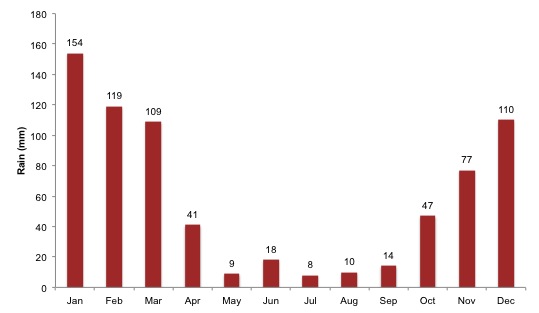
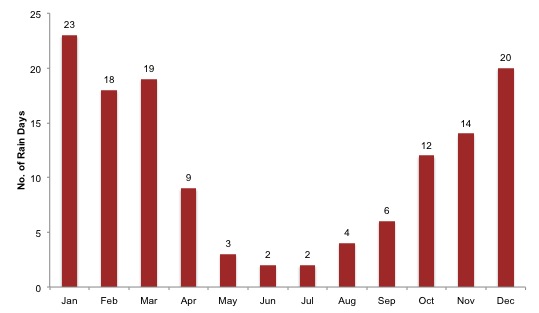
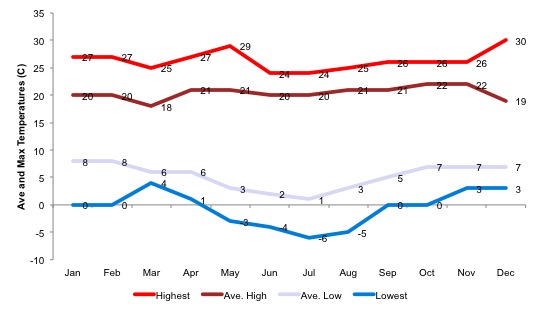
Does it snow in Machu Picchu?
Snow is highly unlikely on Machu Picchu. The Machu Picchu ruins sit at a much lower elevation than other Andean mountains. The climate here is a little warmer and snowfall is rare. Annually, the Machu Picchu weather forecasts predict zero snow days.
Some sources say there was a freak snowfall during the Incan Emperor’s reign. This is possible but hard to confirm.
Minimum temperatures on the mountain drop to -5℃. This is during winter nights from June to August. The rainy season here is between October and April. At this time it is unpleasant to hike and there is more risk of landslides.
Weird Machu Picchu Facts
Was Machu Picchu built by aliens?
A group who call themselves the New Age Andean Cosmologists believe that aliens once inhabited the Cusco region and built Machu Picchu.
They claim the Incas could not have had the technological and architectural know-how to have built Machu Picchu.
Unsurprisingly these views are refuted by all respected research bodies.
Was Machu Picchu used as a site for human sacrifices?
Human sacrifice was a part of Incan culture, but there is little information to suggest that sacrificial killings, of the human kind, happened at Machu Picchu.
The one caveat here is retainer human sacrificial killings. Evidence suggest that these types of sacrifices occurred at Machu Picchu, in which an individual is killed after the death of a noble in order to accompany that person in the afterlife.
Much more common in the Inca culture is the sacrificial killing of animals, particularly the llama. Other forms of offerings include water, dirt and plants, especially coca leaves.
You may also like: Animals in Machu Picchu
Why is nudity a big trend at Machu Picchu?
In recent years, there have been a few cases of tourists posing nude and streaking at Machu Picchu. In some cases tourists caught in the act have been detained and fined.
The Peruvian authorities have started taking ‘Naked tourism’ very seriously and have introduced significant fines for those caught trying to pose for pictures in the nude.
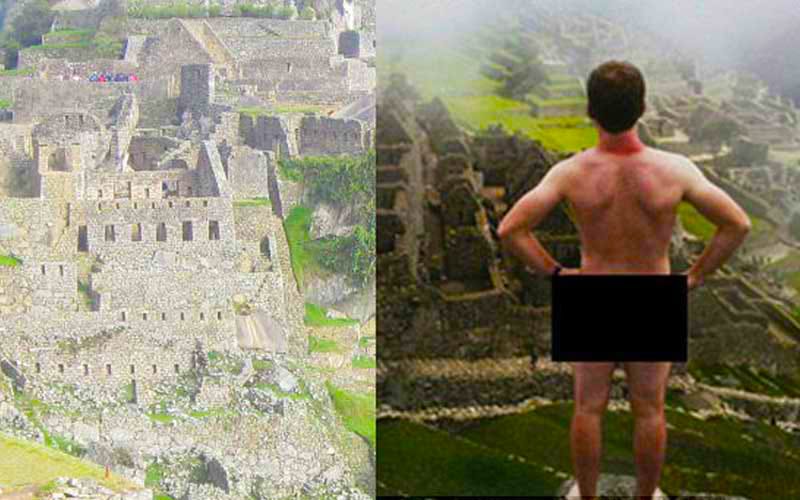
Are landslides a risk at Machu Picchu?
Landslides in the Cusco region are common during the rainy season. But Machu Picchu is relatively safe.
In January 2010, heavy rain in the Sacred Valley resulted in flooding with roads and railway tracks connecting Machu Picchu to Cusco being washed away. Over 2,000 tourists and 2,000 locals were trapped at Machu Picchu and needed to be airlifted to safety. The Citadel was closed for nearly three months.
Has a helicopter landed at Machu Picchu?
In the 1980s, Peruvian authorities removed a large stone from Machu Picchu’s central plaza to make room for a helicopter landing zone. In the 1990s the authorities however changed their policy and forbid any helicopter landings at Machu Picchu.
In 2006, a company in Cusco called Helicusco applied and received a licence to fly helicopter tours over Machu Picchu. The decision to allow the company to fly tours over the city was however quickly overturned. Today, Machu Picchu is a no-fly zone.
Where has Machu Picchu featured in popular culture?
Machu Picchu has appeared in popular culture, especially films and documentaries, since the 1950s.
In 1954 a Paramount Pictures film called Secret of the Incas was filmed on site in Cusco and Machu Picchu, the first time a Hollywood studio filmed within the Citadel.
In 1972, Machu Picchu featured again in a film called Aguirre, the Wrath of God which has sequences filmed from the trail on Huayna Picchu.
The 2004 production of The Motorcycle Diaries, which tells the story of Marxist revolutionary, Che Guerva’s youthful travels, features Machu Picchu.
National Geographic, Discovery Channel, History Channel and NOTV have all produced fascinating documentaries on Machu Picchu.
Contribute to this Machu Picchu facts article
We are constantly adding Machu Picchu facts to this list. If you would to make any additions, or indeed suggest factual corrections, please feel free to contact us.
Tags: Machu Picchu facts, Machu Picchu facts for kids, Machu Picchu Facts and Information, Peru Machu Picchu facts, Machu Picchu facts and history
References: (1) Mark Adams: Turn Right at Machu Picchu: Rediscovering the Lost City One Step at a Time, (2) Hugh Thomson: The White Rock: An Exploration of the Inca Heartland, (3) Kim MacQuarrie: The Last Days of the Incas, (4) Wikipedia, UNESCO’s World Heritage Page for Machu Picchu

I am travelling to Peru in April and would love to visit Machu Picchu. I’m 69 years and fairly fit but I’d like to know if the climb is very strenous. If so is there another way of getting there? Thx
Hi Annette, thanks for getting in touch. The Inca Trail is quite a strenuous trek. It involves 3 solid days of hiking, with one big pass over 4,200m and lots of Inca steps which take their toll on ones knees. However, if you are relatively fit and in good shape there is no reason why you couldn’t complete it. Many people your age and older have done so in the past. I would first do some practice hikes in your home country to see how you feel. If you can do a solid 6 hours hiking and not feel shattered then you should be good to go! All the best.
I have collected some information about Peru’s Machu Picchu, however, I need to write a reference from where I have got the information, therefore, it’s not provided in this website I would like the author’s name and day which was published. Please do respond soon
Author is Mark Whitman. Published 2015.
Thank you very much ! 🙂
Dodo birds🏹